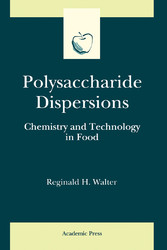Search and Find
Service
Front Cover
1
Polysaccharide Dispersions: Chemistry and Technology in Food
4
Copyright Page
5
Contents
6
Preface
12
Symbols and Abbreviations
14
Chapter 1. Origin and Characteristics of Polysaccharides
20
I. Introduction
20
II. Physical–Chemical State
22
III. Phenomenology
38
IV. Property and Function Modifications
39
V. Volume and the Theta Condition
46
VI. Summary
46
Chapter 2. The Polysaccharide– Water Interface
48
I. Introduction
48
II. Properties of Water
50
III. Polysaccharide–Water Interactions
54
IV. Influences on Polysaccharide–Water Interactions
55
V. Polysaccharides as Adsorbents
57
VI. Polysaccharides as Adsorbates
57
VII. Summary
59
Chapter 3. State- and Path-Dependent Properties
60
I. Introduction
60
II. Mass–Volume–Pressure–Temperature Relationships
60
III. Electrostatics and Electrokinetics
61
IV. Thermodynamics
66
V. Kinetics
70
VI. Hydrodynamics
72
VII. Free Volume
73
VIII. Temperature Dependence
73
IX. Rheology
75
X. Variable-Path Processes
78
XI. Stability and Instability
83
XII. Summary
88
Chapter 4. Concentration Regimes and Mathematical Modeling
90
I. Introduction
90
II. Concentration Regimes
90
III. Mathematical Modeling
93
IV. Size
104
V. Summary
119
Chapter 5. Additivity, Complementarity, and Synergism
120
I. Introduction
120
II. Interactions
120
III. Antagonism
132
IV. Summary
132
Chapter 6. Thermal Processing
134
I. Introduction
134
II. Atmospheric and Retort Processing
134
III. Low-Temperature Pyrolysis
137
IV. High-Temperature Pyrolysis
138
V. Maillard, Amadori, and Strecker Degradations
139
VI. Caramels
139
VII. Summary
140
Chapter 7. Isolation, Purification, and Characterization
142
I. Introduction
142
II. Extraction and Purification
142
III. Analysis
144
IV. Molecular Weights and Sizes
149
V. Colorimetry and Spectrophotometry
156
VI. CD and NMR Spectroscopy
159
VII. Thermal Analysis
160
VIII. Thermodynamic Variables
163
IX. Structural Elucidation
163
X. Volume Fraction
165
XI. Hydrophilicity
165
XII. Surface Area
166
XIII. Fiber
166
XIV. Pilot Plant Quality Control
167
XV. Polysaccharide Theta Conditions
170
XVI. Blending
174
XVII. Summary
174
Chapter 8. Classifications
176
I. Introduction
176
II. Chemical Classification
176
III. Summary
198
Chapter 9. Saccharides in Fat Replacement
200
I. Introduction
200
II. Isolation
202
III. Reactivity
203
IV. Uses
203
V. Fat and Fat Replacement
204
VI. Summary
207
Appendices
208
Appendix 1. Unit of Viscosity
208
Appendix 2. The Schulz–Blaschke Equation
208
Appendix 3. The Maxwell Model
209
Appendix 4. Unit of ./G
209
Appendix 5. The Voigt–Kelvin Model
210
Appendix 6. The Mark–Houwink Equation and the Hydrodynamic Volume
210
References
212
Index
242
Food Science and Technology
256
All prices incl. VAT











